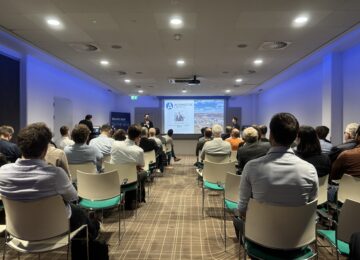Holland's largest battery is nowhere near big enough
In Vlissingen, the largest battery in the Netherlands is being prepared for use. The market for energy storage is growing, but batteries are still too small and too expensive to accommodate the large surpluses of green power.
A light gray block dangles above Flushing's harbor area. It has four blunt legs at the bottom and three lights at the front - there is not much more to it. Inside the block are eight black drawers, and inside those drawers are rods of lithium iron phosphate. Altogether, it weighs about three and a half tons.
A crane lowers the block to just above a pair of metal beams, the same shade of light gray. Three men tackle it and push against it so that it comes down just right. Four bolts through the legs, and then another block. And then 168 times. A few hundred wires in it, an inverter and a transformer, and you have the largest battery in the Netherlands. Starting in the fall, that battery should help with the transition to sustainable energy, despite an overcrowded power grid.
Paul Geluk takes a picture of the work with his phone. "Just to show it to my colleagues." SemperPower, the company he works for, owns the battery, but Geluk has not been to the site in Zeeland before.
The three-year-old Amsterdam-based company leaves the installation of the battery modules to the general contractor. And SemperPower also has little to do with the electricity that will soon flow through them.
"We will soon lease the battery to different parties," Geluk explains. One third is for energy supplier Essent; he is not allowed to say anything about the other two third parties. For a monthly fee, together they will have 63 megawatt hours of energy storage at their disposal, enough to power roughly one hundred thousand households for two hours.
Fluctuations on the net
Powering households is not so much the purpose of the battery - rather, preventing power outages. Here's the thing.
Energy suppliers such as Essent predict a day in advance how much power they will need each quarter-hour and purchase power on that basis from energy producers such as EPZ, the owner of the Borssele nuclear power plant. Fifteen minutes before the power is delivered, there is another correction moment when energy producers definitively indicate how much power is coming and energy suppliers let them know how much they need.
After that 15 minutes, unexpected differences from the forecast still arise. A cloud passes over a solar farm, a train comes to a halt, a windmill snaps. Such differences increase or decrease the power grid frequency, which should remain around 50 hertz. Excessive deviation leads to power outages. To prevent this, high-voltage grid operator Tennet has what is known as Frequency Containment Reserve (FCR), also known as primary reserve power. Part of the space that power producers have to make power, they keep it free so Tennet can call on it. Within thirty seconds, they must be able to supply more or less power. For that, they get a fee per day and some more money for the power.
Being able to turn on and off quickly is crucial to compete in the FCR market. A nuclear plant cannot do that, a gas plant can, and a battery even better. So a battery tenant like SemperPower's can make a profit by being ready for Tennet quickly. The flip side: Tennet only needs 111 megawatts this year to handle such fluctuations, and there are already more than enough batteries for that.
Then there is the slightly slower Automatic Frequency Restoration Reserve (aFRR), which Tennet calls on when longer differences occur. The wind picks up, clouds clear unexpectedly, a chemical plant stops running. Those contributing to the aFRR must be able to provide or absorb additional power within five minutes. This market also has a downside: to participate, a party must be able to provide power for 24 hours - inconvenient for a battery that can only run at full power for two hours. The rules will change later this year; until then, batteries can contribute little to this "secondary reserve power.
Finally, there is "voluntary trading" in imbalance, where power providers can sell or buy electricity to keep supply and demand equal. Essent is going to do something similar with the Zeeland battery: when the demand for energy slumps for a while, the energy supplier puts the excess power in, to be used later to fill gaps again. Compare it to a greengrocer who puts some lettuce in the cooler when there are fewer customers than expected.
This "imbalance market" isn't everything, either, wrote consulting firm CE Delft in late 2021 in a study of battery storage. Batteries are not expected to be able to make a profit there until 2030.
:strip_icc()/s3/static.nrc.nl/bvhw/files/2023/06/batterijextra.jpg)
So remedying peaks and troughs on the power grid still seems to yield little return, and yet battery companies are betting on it. Indeed, a combination of FCR, aFRR and voluntary trading, for example, can be profitable, according to calculations by CE Delft. By around 2030 there is room in the 'imbalance market' for up to 2 gigawatts, i.e. more than sixty batteries like the one SemperPower is now installing at Vlissingen.
The more popular renewable energy becomes, the greater the fluctuations, Geluk expects. The power output of a wind or solar farm is simply more difficult to predict than that of a power plant. "The predictions are getting better, but green power is growing even faster." And the market for parties who absorb the fluctuations grows along with it.
Wasted energy
Fixing imbalance is useful, but the real challenge lies elsewhere. The supply of renewable power can still be so predictable and yet come at an inconvenient time. The wind does not keep up with the demand for electricity, and on a winter day the sun may shine during the day, but that power is only needed when it's dark and the heating comes on at home.
It already happens with some regularity that energy prices are negative because of a surplus of renewable energy. Dutch solar panels can deliver 14 gigawatts in the afternoon when only 12 gigawatts are needed. Selling energy abroad at such times is not enough to dispose of it all. Sometimes wind or solar farms have to be turned off temporarily. A shame - there is renewable energy, but nowhere to put it, while at other times there is a shortage. If this continues, by 2030 the security of supply will be at stake, Tennet warned early this year.
Batteries seem like a simple solution: capture energy when the sun shines and the wind blows and release it when it's dark or windless, or even store it in the summer and distribute it in the winter. But there is still a long way to go. CE Delft analysts do not foresee batteries playing a meaningful role as "arbitrage" in the energy market until after 2030.
"The small peaks should also be solved, batteries were already ready for that," says Dorine Hugenholtz. Her graduation research at TU Delft was about this, and she now works at energy supplier Vattenfall on battery projects. "For the hills of weeks, months or seasons, batteries are not yet suitable."
The two hours the battery at Vlissingen can run at full power is far too short to make a completely sustainable energy supply possible. Putting up dozens of such battery parks to make an even bigger battery is not the solution either, because all those batteries are very expensive. SemperPower invested some 27 million euros in the 168 light gray blocks that are now being erected. And a battery that is full of power for a week does not make money.
According to Hugenholtz, the wait is for even more renewable energy and for batteries to become better and cheaper. She also hopes that grid use will become cheaper. "There is no separate category for batteries, so we pay the same amount as a large factory. That's a big bottleneck in the rollout of energy storage."
Pushing for a connection
As if it were all not complicated enough, there is also grid congestion, which thwarts the emergence of energy storage. "A traffic jam on the power grid," is how Geluk articulates the problem. Here it's not a shortage or surplus of power, but too narrow a cable through which all that electricity has to pass.
The connections that SemperPower gets take a "huge bite" out of the space left by local grid operator Stedin, a spokesman says. "After this, we have very little power left," he said.
So it is no coincidence that SemperPower's battery will be in the Vlissingen port area, close to a row of wind turbines, a nuclear power plant and a gas power plant. It is one of the few places that is on grid congestion map still colors all white. "Everything here is set up to carry masses of electrons," Geluk said.
:strip_icc()/s3/static.nrc.nl/bvhw/files/2023/06/web-0506eco-batterij1.jpg)
Other battery companies are only too happy to have such a connection, says the Stedin spokesman. "When North Brabant and Limburg announced that things were locking up, we got a lot of battery parties from the south asking us for space on the grid." A grid connection without ifs or buts as SemperPower gets here, Stedin will not give it away again.
The congestion on the power grid does not have to be an obstacle, Geluk emphasizes. "Because of congestion, municipalities have become reluctant to issue permits for batteries, but with the right agreements, a battery doesn't put any extra pressure on the grid at all."
"Congestion-neutral operation," is what it's called in jargon. It means allowing a battery to do nothing for a while at times of congestion. Grid operators like Stedin can charge for that in turn, but Geluk says that's not even necessarily necessary. "If our battery does nothing for a month, it hardly degrades and at the end of the day we can use it a month longer."
A battery can even help to eliminate congestion on the power grid. If it is in the right place and charges and discharges at the right time, the battery can provide power that would otherwise not fit through the cable. According to CE Delft, it is at most part of the solution to the congestion problem, and Geluk agrees. "Strengthening the power grid is number one," he says.
Successor
While the largest battery in the Netherlands is being prepared for use, other batteries are already about to overtake it. Twenty meters away, on the other side of the fence surrounding the Vlissingen construction site, SemperPower has already made preparations for an installation with a capacity of 68 megawatt hours. Meanwhile, competitor Giga Storage in Delfzijl says it is working on the largest battery in Europe. And then there are the promises of new types of energy storage that could smash all those records again, such as underground cavities full of compressed air or a liquid flow battery.
The light gray blocks will be in the Vlissingen port area for about ten years. They lose a few percent of their storage capacity each year and after about ten years are too "small" to be used here. Then they will go to other places where that is less of a problem, to be recycled at the end.
What will take its place ten years from now, Geluk does not yet know. "Developments are going so fast now, by then there will probably be something new," he said.
Source: NRC
Photos: Walter Autumn





